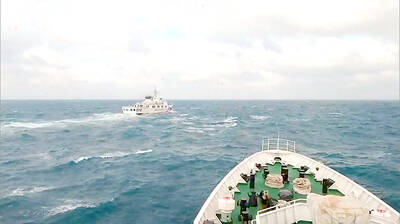Southeast Asian nations yesterday expressed serious concern about growing international tension over disputed waters in the South China Sea.
China claims most of the sea, but Taiwan, Malaysia, the Philippines, Brunei and Vietnam have rival claims to all or portions of the region. Friction has increased over China’s recent deployment of missiles and fighter jets to the disputed Paracel Islands (Xisha Islands, 西沙群島).
“Ministers remained seriously concerned over recent and ongoing developments,” 10-member ASEAN said in a statement after a regular meeting of the group’s foreign ministers in Laos.
Land reclamation and escalating activity has increased tensions and could undermine peace, security and stability in the region, ASEAN said in the statement.
The US has criticized China’s building of artificial islands and facilities in the sea and has sailed warships close to disputed territory to assert the right to freedom of navigation.
The White House on Friday pressed Chinese President Xi Jinping (習近平) to expand his non-militarization pledge to cover the entire South China Sea.
During a state visit to the US in September last year, Xi insisted that “China does not intend to pursue militarization” in the Spratly Islands (Nansha Islands, 南沙群島).
“We think it would be good if that non-militarization pledge, if he [Xi] would extend that across the entire South China Sea,” US National Security Council Senior Director for Asian Affairs Daniel Kritenbrink told a forum at the Center for Strategic and International Studies in Washington. “We’re going to encourage our Chinese friends and other countries in the region to refrain from taking steps that raise tensions.”
Vietnam, which accused China of violating its sovereignty with the missile deployment, yesterday echoed the US call.
“We call for non-militarization in the South China Sea,” Vietnamese Deputy Prime Minister and Minister of Foreign Affairs Pham Binh Minh told reporters after meeting with his ASEAN colleagues.
The group agreed to seek a meeting between China and ASEAN’s foreign ministers to discuss the South China Sea and other issues, Cambodian Minister of Foreign Affairs and International Cooperation Hor Namhong said.
China’s maritime claims are ASEAN’s most contentious issue, as its members struggle to balance mutual support with their growing economic relations with Beijing. China is the biggest trade partner for many ASEAN nations.
Vietnam and China compete for influence over landlocked Laos, which has no maritime claims, but finds itself in the difficult position of dealing with neighbors at odds over the South China Sea. Laos is tasked with finding common ground on the issue as the ASEAN chair this year.
Laotian Deputy Prime Minister and Minister of Foreign Affairs Thongloun Sisoulith, who is to take office as prime minister next month, played down the challenge.
“We are a close friend of Vietnam and China. We try to solve problems in a friendly way,” he told reporters yesterday. “We are in the middle, but it’s not a problem.”

Auckland rang in 2026 with a downtown fireworks display launched from New Zealand’s tallest structure, Sky Tower, making it the first major city to greet the new year at a celebration dampened by rain, while crowds in Taipei braved the elements to watch Taipei 101’s display. South Pacific countries are the first to bid farewell to 2025. Clocks struck midnight in Auckland, with a population of 1.7 million, 18 hours before the famous ball was to drop in New York’s Times Square. The five-minute display involved 3,500 fireworks launched from the 240m Sky Tower. Smaller community events were canceled across New Zealand’s

The Ministry of Foreign Affairs (MOFA) yesterday said it is closely monitoring developments in Venezuela, and would continue to cooperate with democratic allies and work together for regional and global security, stability, and prosperity. The remarks came after the US on Saturday launched a series of airstrikes in Venezuela and kidnapped Venezuelan President Nicolas Maduro, who was later flown to New York along with his wife. The pair face US charges related to drug trafficking and alleged cooperation with gangs designated as terrorist organizations. Maduro has denied the allegations. The ministry said that it is closely monitoring the political and economic situation

UNRELENTING: China attempted cyberattacks on Taiwan’s critical infrastructure 2.63 million times per day last year, up from 1.23 million in 2023, the NSB said China’s cyberarmy has long engaged in cyberattacks against Taiwan’s critical infrastructure, employing diverse and evolving tactics, the National Security Bureau (NSB) said yesterday, adding that cyberattacks on critical energy infrastructure last year increased 10-fold compared with the previous year. The NSB yesterday released a report titled Analysis on China’s Cyber Threats to Taiwan’s Critical Infrastructure in 2025, outlining the number of cyberattacks, major tactics and hacker groups. Taiwan’s national intelligence community identified a large number of cybersecurity incidents last year, the bureau said in a statement. China’s cyberarmy last year launched an average of 2.63 million intrusion attempts per day targeting Taiwan’s critical

‘SLICING METHOD’: In the event of a blockade, the China Coast Guard would intercept Taiwanese ships while its navy would seek to deter foreign intervention China’s military drills around Taiwan this week signaled potential strategies to cut the nation off from energy supplies and foreign military assistance, a US think tank report said. The Chinese People’s Liberation Army (PLA) conducted what it called “Justice Mission 2025” exercises from Monday to Tuesday in five maritime zones and airspace around Taiwan, calling them a warning to “Taiwanese independence” forces. In a report released on Wednesday, the Institute for the Study of War said the exercises effectively simulated blocking shipping routes to major port cities, including Kaohsiung, Keelung and Hualien. Taiwan would be highly vulnerable under such a blockade, because it